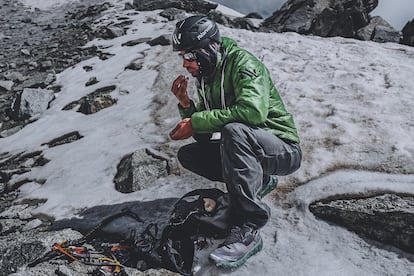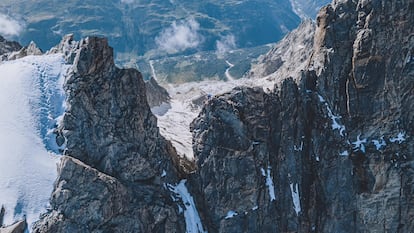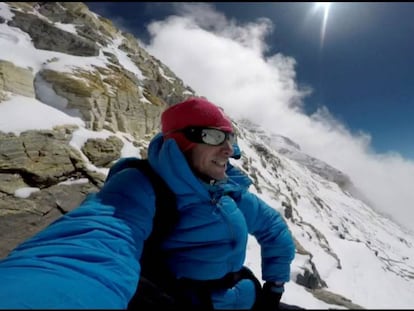Kílian Jornet and the challenge of 82 four-thousand-meter peaks: ‘He feels physically perfect but, at times, psychologically tired’
The team that’s accompanying the Spanish trail runner in his attempt to cross the Alps speaks with EL PAÍS. They discuss the logistics involved and the athlete’s special diet as he climbs 59 mountains in just two weeks. ‘He hasn’t lost any weight!’

Fifteen days after beginning his challenge of climbing the 82 four-thousanders — or 4,000-meter peaks — in the Alps, Spanish trail runner Kílian Jornet has already completed 59 summits. If all goes well, by next week, he will have successfully completed an athletic feat that will smash the record set in 2008, when guides Franco Nicolini and Diego Giovannini completed the Alpine crossing in 60 days.
The ultra-runner’s journey isn’t strictly a solo trip — it’s a scrupulously organized journey, designed to bolster his speed. However, Jornet only moves thanks to the momentum of his legs: he doesn’t use ski lifts or motor vehicles to move from one environment to another. He only uses a road bike when he comes down from the mountains and hits the pavement.
A team of half-a-dozen people — which includes the mountaineer’s mother — is responsible for filming his progress and for supplying and assisting him when he reaches the road in the valleys. There, two vans welcome him and watch him eat like crazy “for an hour-and-a-half straight.”
“It’s amazing to see the amount of food he eats,” members of his team chuckle. “Then, he goes to sleep in the van until he gets up to start a new stage.”
When he wakes up, he picks out the appropriate clothing and the technical equipment he will use. He then mounts his bike and travels to the chosen point, where he swaps the two wheels for some shoes and sets off up the slope. He pedals without weight. And, in the mountains, he only carries a minimalist backpack.
Over the years, Kílian Jornet has become accustomed to drinking very little water during his training sessions. He can go without drinking for several hours. This is particularly useful in the mountains, where there are no water fountains. There’s snow, but he would have to melt it with a stove and add salt to properly hydrate himself. Instead, he starts each day’s route with a litre of water and buys bottles from the hostels he passes by.
“In some [rest stations], he feels bad when they want to treat him to special food. He asks to eat the same fare as everyone else and sleep in the shared rooms. In this sense, he always maintains a very humble profile, despite the interest his figure arouses as he passes by,” the team notes.
Jornet expends around 6,000 calories during the longest stages of his mountain runs. But there’s a bigger story behind this mountaineer, as explained by his doctor, Jesús Álvarez: “Based on the previous work carried out and knowing what his microbiota (microscopic flora) and physiological state are like, our objective isn’t to count calories, but to maintain physiological functions according to the inputs we receive daily (the athlete provides saliva and stool samples). From there, we individualize his diet, based on the needs of macronutrients or micronutrients.”
“Basically,” Dr. Álvarez continues, “what we try to do is compensate for the altered physiological states that are produced by activity, sleep deprivation, stress, etc. In these situations, it’s more about achieving physiological, metabolic and neuroendocrine restitution and not so much about adding calories. [We look at] what can be absorbed and what will benefit him. There’s a very clear relationship with the state of the microbiota and the intestinal capacity that favors metabolism and use of food. The human body isn’t like a train with coal in it: it burns so much and moves so far. The body assimilates — or not — depending on what state it’s in.”

In his backpack, Jornet carries some high-calorie bars that he made himself at home, in Norway. He alternates these with sandwiches and tasty snacks made by his mother. In the rest stations, he eats whatever’s available.
During his training sessions, Jornet isn’t used to eating anything at all. But during his races, he has learned to eat steadily. In fact, his team estimates that he hasn’t lost any weight in the last two weeks. “When he climbed 177 Pyrenean ‘three-thousanders’ in eight days a few months ago, he lost [15 pounds]. It was a very different trip, much more demanding and extreme. Here, in the Alps, the experience is different. Kilian is very calm, quiet. He allows himself more hours of sleep, he’s not obsessed with the stopwatch, he doesn’t compete against anything or anyone,” his companions explain.
The athlete, who originally hails from Catalonia, sometimes travels while accompanied by other mountaineers or guides, who help him in certain areas, whether for anything technical, or if something unknown arises. Thus, his trip isn’t completely solitary. “Kílian values the company of these friends. [Even though] he’s physically fit, he sometimes feels the psychological toughness of the challenge, a certain mental fatigue,” his entourage explains.
In August, the Alps are especially dangerous, with ground conditions that deteriorate rapidly amid unstable, rocky terrain. There are many dangers to avoid, meaning that routes and itineraries have to be altered on the fly.
“We never know when he’ll arrive,” his teammates sigh. “We just wait. We send him a message when we think he’s taking too long and we receive his response with relief. When he finally arrives, he tells us about his adventures while he eats.”
“If we compare the plan for the journey that he sent us six months ago with what he’s ended up doing, the differences are substantial,” the teammates continue. The terrain and weather conditions are always the order of the day, which adds stress and forces the Spaniard to rely on his anticipation and ability to adapt.
To date, Jornet has racked up 530 miles, 59 four-thousanders, 196 hours and 43 minutes of effort, spread over 12 stages (15 days) and a positive gradient of 184,504 feet. The 12th stage allowed him to cross the Grandes Jorasses mountain, a journey between the wild French north face — where many of the best chapters in the history of mountaineering have been written — and the more pleasant Italian side. The final stretch of his challenge will cover an essential part of the scenarios where mountaineering was born, grew and evolved... until reaching the high-speed era of the present.
Sign up for our weekly newsletter to get more English-language news coverage from EL PAÍS USA Edition
Tu suscripción se está usando en otro dispositivo
¿Quieres añadir otro usuario a tu suscripción?
Si continúas leyendo en este dispositivo, no se podrá leer en el otro.
FlechaTu suscripción se está usando en otro dispositivo y solo puedes acceder a EL PAÍS desde un dispositivo a la vez.
Si quieres compartir tu cuenta, cambia tu suscripción a la modalidad Premium, así podrás añadir otro usuario. Cada uno accederá con su propia cuenta de email, lo que os permitirá personalizar vuestra experiencia en EL PAÍS.
¿Tienes una suscripción de empresa? Accede aquí para contratar más cuentas.
En el caso de no saber quién está usando tu cuenta, te recomendamos cambiar tu contraseña aquí.
Si decides continuar compartiendo tu cuenta, este mensaje se mostrará en tu dispositivo y en el de la otra persona que está usando tu cuenta de forma indefinida, afectando a tu experiencia de lectura. Puedes consultar aquí los términos y condiciones de la suscripción digital.
More information
Archived In
Últimas noticias
Welcome to the post-religion era: The idea of Christianity as the absolute truth has become obsolete
‘I thought you would like it’: The risky sexual practice popularized by TV shows and TikTok
The digitalization of tourism: ‘They promise experiences and gave us the worst possible one’
Mexican peso defies uncertainty with forecasts of a new period of stability in 2026
Most viewed
- Sinaloa Cartel war is taking its toll on Los Chapitos
- Oona Chaplin: ‘I told James Cameron that I was living in a treehouse and starting a permaculture project with a friend’
- Reinhard Genzel, Nobel laureate in physics: ‘One-minute videos will never give you the truth’
- Why the price of coffee has skyrocketed: from Brazilian plantations to specialty coffee houses
- Silver prices are going crazy: This is what’s fueling the rally










































